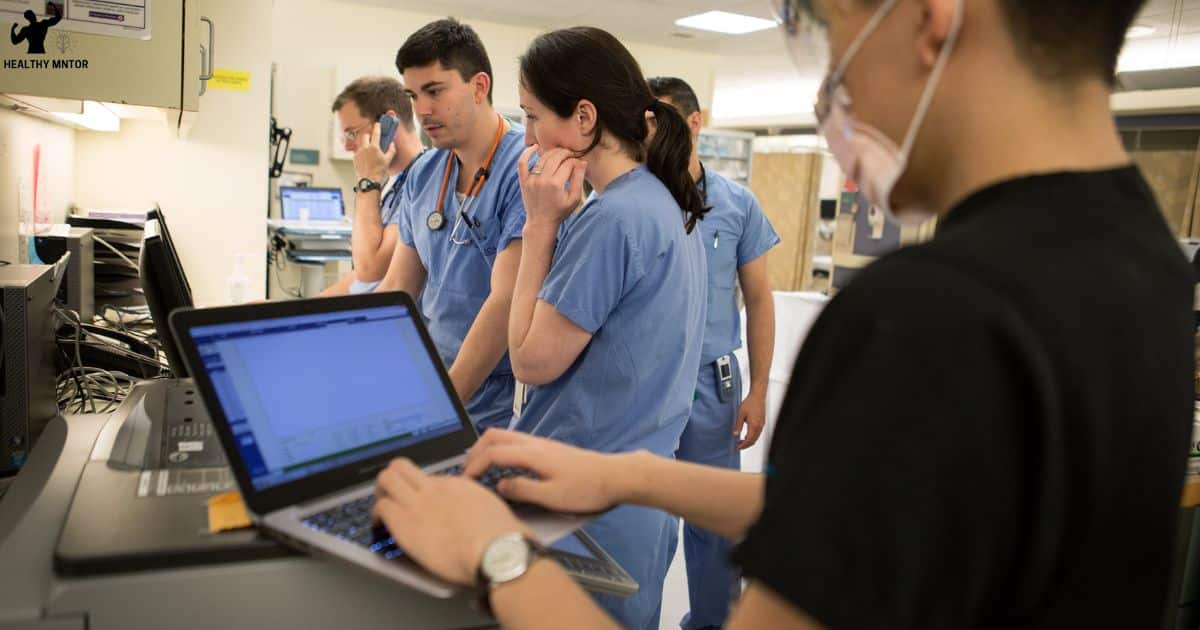In the increasingly digital world of healthcare, nurses play a vital role in utilizing health informatics to enhance patient care. Through the integration of technology, such as electronic health records and telehealth systems, nurses are able to provide efficient and accurate care. By leveraging clinical decision support systems and big data analytics, nurses can improve patient safety and population health management. This article will explore how nurses effectively utilize health informatics to provide high-quality and personalized care in today’s rapidly evolving healthcare landscape.
Key Takeaways
- Electronic Health Records (EHRs) facilitate seamless communication and collaboration among healthcare professionals, ensuring accurate information exchange and improved patient care.
- Telehealth and telemedicine technologies enable remote examination and accurate diagnoses, improving access to care for individuals in rural or underserved areas and enhancing coordination of care among multiple healthcare providers.
- Clinical Decision Support Systems (CDSS) help healthcare professionals make more informed and accurate decisions by providing evidence-based recommendations and timely alerts, reducing medication errors and integrating patient-specific information with clinical guidelines.
- Big Data Analytics allow for the analysis of population health trends and the identification of effective strategies, enabling proactive interventions and targeted interventions based on predictive modeling.
The Role of Electronic Health Records (EHRs
Electronic health records (EHRs) play a crucial role in facilitating seamless communication and collaboration among healthcare professionals, ensuring accurate information exchange and improved patient care. The benefits of interoperability in EHRs cannot be overstated. By allowing different healthcare systems and providers to exchange data and communicate effectively, interoperability enhances care coordination and decision-making. It enables healthcare professionals to access comprehensive patient information at any point of care, leading to better diagnoses, treatment plans, and outcomes. However, with the increased reliance on EHRs, data security becomes paramount. Strict measures must be in place to protect patient information from unauthorized access and breaches. Robust data encryption, user authentication, and regular audits are essential to maintain the privacy and integrity of EHRs. As we discuss the utilization of telehealth and telemedicine technologies, it is important to recognize how EHRs form the backbone of these innovations, enabling seamless integration and communication between healthcare providers and patients.
Utilizing Telehealth and Telemedicine Technologies
Telehealth and telemedicine technologies provide healthcare professionals with the opportunity to remotely examine patients and make accurate diagnoses, ensuring timely and efficient healthcare delivery. These technologies offer numerous benefits, particularly in the realm of remote patient monitoring. With remote patient monitoring, healthcare providers can monitor patients’ vital signs and health conditions from a distance, eliminating the need for in-person visits and reducing the risk of exposure to infectious diseases. This method of healthcare delivery also improves access to care for individuals in rural or underserved areas who may have limited access to healthcare facilities. Additionally, telehealth allows for improved coordination of care among multiple healthcare providers, leading to better patient outcomes. As technology continues to advance, telehealth is becoming an integral part of healthcare delivery, offering convenience, efficiency, and improved patient care.
Enhancing Patient Safety Through Clinical Decision Support Systems (Cdss
Implementing robust clinical decision support systems (CDSS) can significantly improve patient safety by providing healthcare professionals with evidence-based recommendations and timely alerts when making critical treatment decisions. CDSS can play a crucial role in reducing medication errors, adverse drug events, and improving overall patient outcomes. These systems are designed to integrate patient-specific information, such as medical history, laboratory results, and medication records, and combine it with clinical guidelines and best practices to provide clinicians with real-time decision support. The use of CDSS can help healthcare professionals make more informed and accurate decisions, ensuring that patients receive the most appropriate and effective care. Clinical alerts generated by CDSS can alert clinicians to potential drug-drug interactions, allergies, or other contraindications, preventing harmful or potentially life-threatening situations. By incorporating CDSS into clinical workflows, healthcare organizations can enhance patient safety and improve overall quality of care. Let’s find out more information about How Would a Nurse Use Health Informatics in Patient Care? In this article.
Leveraging Big Data Analytics for Population Health Management
Healthcare organizations can leverage big data analytics to analyze population health trends and identify effective strategies for improving overall health outcomes. By collecting and analyzing large amounts of data from diverse sources such as electronic health records, wearable devices, and social media, healthcare organizations can gain valuable insights into the health of populations and make data-driven decisions. However, it is essential to address concerns regarding data privacy to ensure that patient information is protected and used responsibly. Predictive modeling is a powerful tool that can be used to forecast future health trends and identify individuals at risk of developing certain conditions. By implementing predictive modeling techniques, healthcare organizations can proactively intervene and provide targeted interventions to improve health outcomes. Overall, leveraging big data analytics and predictive modeling can revolutionize population health management and lead to more effective healthcare strategies.
Improving Medication Management With Computerized Physician Order Entry (Cpoe
By implementing computerized physician order entry (CPOE), healthcare providers can significantly improve medication management by reducing errors and enhancing efficiency. CPOE allows healthcare professionals to electronically prescribe medications, eliminating the need for handwritten prescriptions which are prone to errors. With CPOE, medication orders are automatically checked for potential drug interactions, allergies, and appropriate dosages, reducing the risk of medication errors. Additionally, CPOE improves workflow efficiency by eliminating the need for manual transcription of orders, allowing for faster processing and reducing delays in medication administration. The integration of CPOE in healthcare systems not only improves patient safety but also streamlines medication management, ultimately enhancing the overall quality of care. Transitioning into the subsequent section about integrating health informatics in nursing education and training, the use of CPOE is a prime example of how health informatics can be utilized in patient care.
Integrating Health Informatics in Nursing Education and Training
Nursing education and training can benefit from the integration of health informatics through the utilization of advanced technology for data analysis and improved patient care. With the rapid advancements in healthcare technology, nursing informatics has become an essential component of nursing practice. By incorporating health informatics into their education and training, nurses can enhance their ability to provide high-quality care and contribute to the overall improvement of patient outcomes.
To fully understand the significance of integrating health informatics in nursing education and training, consider the following:
- Access to real-time patient data, enabling nurses to make informed decisions and provide timely interventions.
- Use of electronic health records (EHRs) for more accurate and comprehensive documentation, facilitating continuity of care.
- Utilization of data analytics to identify trends and patterns, leading to evidence-based practice.
- Enhanced communication and collaboration among healthcare professionals through interoperable systems.
Frequently Asked Questions
What Are the Benefits of Using Electronic Health Records (Ehrs) in Patient Care?
Electronic health records (EHRs) offer numerous benefits in patient care. They improve efficiency by providing instant access to patient information, facilitating communication among healthcare providers, reducing errors, and enabling better coordination of care, ultimately improving patient outcomes.
How Do Telehealth and Telemedicine Technologies Improve Access to Healthcare for Patients?
Telehealth and telemedicine technologies greatly enhance access to healthcare by improving efficiency and enabling remote monitoring. These advancements allow patients to receive timely care and consultations from healthcare professionals, regardless of their physical location.
What Is the Role of Clinical Decision Support Systems (Cdss) in Enhancing Patient Safety?
Clinical decision support systems (CDSS) play a crucial role in enhancing patient safety by providing nurses with evidence-based recommendations, alerts, and reminders. These systems improve clinical decision-making, reduce errors, and facilitate the delivery of high-quality, personalized care.
How Can Big Data Analytics Be Used to Improve Population Health Management?
Big data applications and predictive analytics are valuable tools in improving population health management. By analyzing large datasets, healthcare professionals can identify trends, predict disease outbreaks, and tailor interventions to specific populations, ultimately improving overall health outcomes.
What Are the Advantages of Computerized Physician Order Entry (Cpoe) in Medication Management?
The advantages of computerized physician order entry (CPOE) in medication management are numerous. The use of CPOE improves patient safety, reduces medication errors, enhances communication between healthcare professionals, and increases efficiency in healthcare delivery. Nurses play a crucial role in utilizing health informatics, including CPOE, to ensure the effective and safe management of medications for their patients.
Conclusion
In conclusion, health informatics plays a crucial role in enhancing patient care and safety for nurses. Through the use of electronic health records, telehealth technologies, clinical decision support systems, big data analytics, and computerized physician order entry, nurses are able to improve efficiency and accuracy in their practice. Furthermore, the integration of health informatics in nursing education and training enables nurses to stay updated with the latest advancements in healthcare technology. Irony lies in the fact that while technology enhances patient care, it also poses challenges in terms of data privacy and security.






